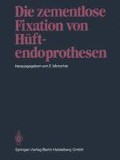Zusammenfassung
Aus der großen Palette hochwertiger keramischer Werkstoffe kommen für Implantatzwecke nur wenige in Frage. Die Auswahl beschränkt sich gegenwärtig auf die hochreinen chemisch beständigen Oxide. Neben der für Implantate erforderlichen maximalen Biokompatibilität, die nicht nur von den chemischen Parametern, sondern auch ganz wesentlich von der kristallinen Struktur und anderen physikalischen Eigenschaften des Werkstoffs abhängt, sind für den Implantateinsatz noch weitere wichtige Auswahlkriterien zu erfüllen:
-
Hohe mechanische Dauerfestigkeit für hohe Funktionssicherheit und lange Lebensdauer
-
exakte Formbarkeit und enge Maßtoleranzen für die sphärischen Komponenten der künstlichen Gelenke
-
extreme Oberflächenguten für die Artikulation mit anderen künstlichen oder natürlichen Partien.
Access this chapter
Tax calculation will be finalised at checkout
Purchases are for personal use only
Preview
Unable to display preview. Download preview PDF.
Literatur
Boutin P (1972) Arthroplastic totale de la hanche par prothèse en alumine frittée. Rev Chir Orthop 58: 229–246
Boutin P (1977) L’arthoplastie totale de la hanche par prothèse en alumie. Résultats de 150 cas d’ancrage direct de la pièce acétabulaire. Int. Orthop 1: 87–94
Griss P, Heimke G, Andrian-Werburg H y (1975) Die Aluminiumoxidkeramik-Metall-Verbundprothese. Eine neue Hüftgelenktotalendoprothese zur teilweise zementfreien Implantation. Arch Orthop Unfallchir 81: 259–266
Heimke G, Beisler W, Andrian-Werburg H v, Griss P, Krempien B (1973) Untersuchungen an Implantaten aus Al2O3-Keramik. Berichte der Dtsch. Keram. Ges. 50: 4–8
Hulbert SF, Young FA, Mathews RS, Klawitter JJ, Talbert CD, Stelling FH (1970) Potential of ceramic materials as permanently implantable skeletal prosthesis. J Biomed Mater Res 4: 433–456
Maier HR, Krauth A, Stärk N, Zeibig A (1982) Long life ceramic-metal hip joints. In: Winter GD, Gibbons DF, Plenk H Jr (eds) Biomaterials 1980. Wiley & Sons, New York Chichester
Mathejovsky Z (1973) Results of arthroplasty in tumors affecting the hip. Arthroplasty of the hip. Thieme, Stuttgart, p 226
Mittelmeier H (1976) Anchoring hip endoprostesis without bone cement. In: Schaldach M, Hohmann D (eds) Engineering in medicine, vol 2. Advances in artificial hip and knee joint technology. Springer, Berlin Heidelberg New York
Plenk H (1982) Biocompatibility of ceramics in joint prostheses. In: William DF (ed) Biocompatibility of orthopedic implants — vol 1: 269–295 CRC incorp. Boca Raton
Predecki P, Auslaender PA, Stephan JE, Mooney VL, Stanitski C (1972) Attachment of bone to threaded implants by ingrowth and mechanical interlocking. J Biomed Mater Res 6: 401–412
Salzer M, Locke H, Engelhardt A, Zweymüller K (1975) Keramische Endoprothesen der oberen Extremität. Kongreßband. Z Orthop 113: 458–461
Salzer M, Zweymüller K, Locke H, Plenk H Jr, Punzet G (1975) Biokeramische Endoprothesen. Med Orthop Techn 95: 40
Scales JT, Wright JKW (1980) The evaluation of wear of total hip prostheses. In: Winter GD, Leary GL. The evaluation of biomaterials, p 141. John Wiley Sons
Semlitsch M, Willert HG, Dörre E (1975) Neue Werkstoffpaarung Al2O3-Keramik/Polyäthylen zur Verminderung des Polyäthylenabriebs bei Gelenkpfannen von Hüftendoprothesen. Med Orthop Techn 95: 143–144
Ungethüm M, Hinterberger J, Plitz W (1978) Tribologica. Properties of Al2O3-ceramica. In: Hastings, Williams (eds) Advances in biomaterials. Mechanical properties of biomaterials. Wiley, London
Editor information
Editors and Affiliations
Rights and permissions
Copyright information
© 1983 Springer-Verlag Berlin Heidelberg
About this paper
Cite this paper
Zeibig, A. (1983). Keramik als Implantatmaterial. In: Morscher, E. (eds) Die zementlose Fixation von Hüftendoprothesen. Springer, Berlin, Heidelberg. https://doi.org/10.1007/978-3-662-00967-3_13
Download citation
DOI: https://doi.org/10.1007/978-3-662-00967-3_13
Publisher Name: Springer, Berlin, Heidelberg
Print ISBN: 978-3-662-00968-0
Online ISBN: 978-3-662-00967-3
eBook Packages: Springer Book Archive

